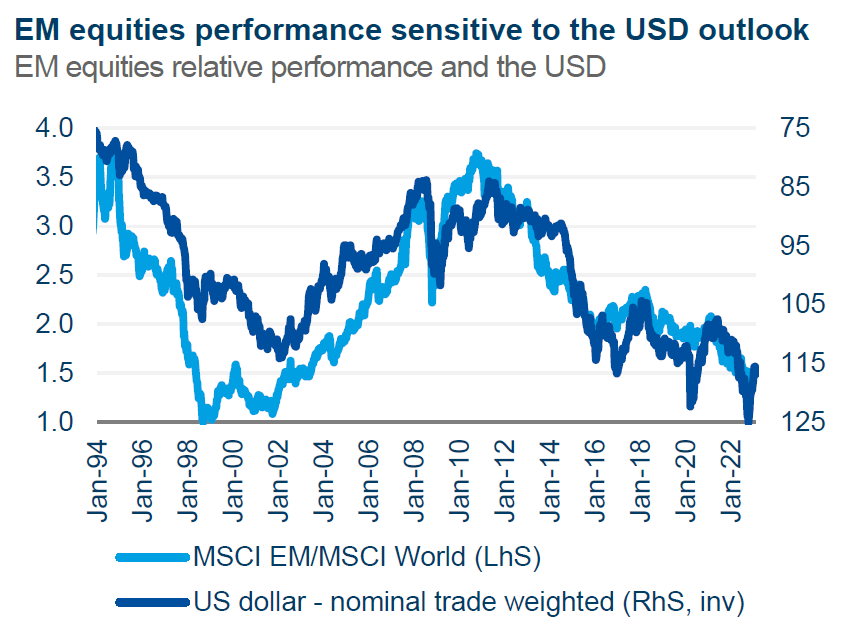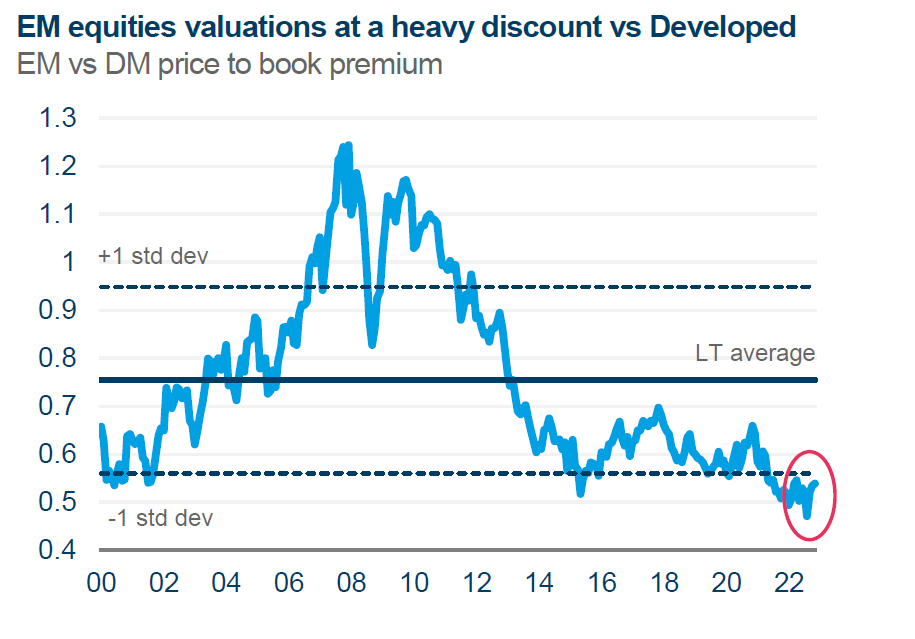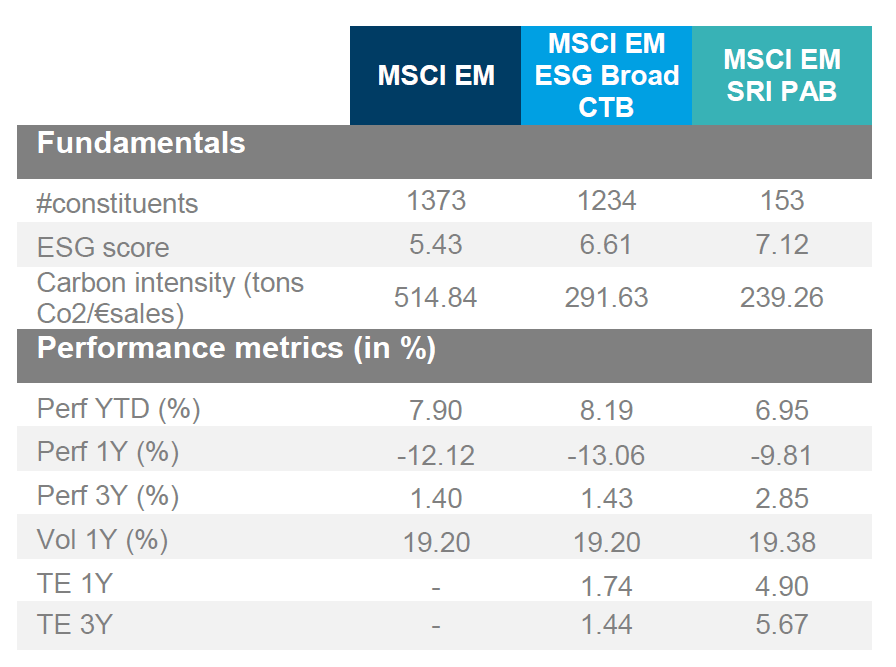Emerging markets: from laggard to leader?
Share

With the peak of inflation likely behind us, and China reopening its economy earlier than expected, emerging markets are back on investors’ radar. Yet the global scenario remains complex and ‘emerging markets’ encapsulates a fragmented and diverse collection of countries, meaning investors have several options to consider. With changes afoot, we believe now is the time to reassess your exposure to emerging markets.
The performance of emerging market (EM) equities was mixed last year, held back by the underperformance of Chinese equities and tighter liquidity conditions. Looking ahead to where they go next, two main factors are likely to play an important role: the US dollar, and China.
A strong dollar tends to accentuate the period of correction when EM economic activity declines. It also often leads to tighter credit conditions (due to these countries’ USD financing) and higher inflation.
On the flip side, when economic activity in EM trends upwards, local currencies strengthen, leading to better economic performance. The chart below shows that EM equities tend to outperform developed market (DM) equities when the US dollar is weaker. With the dollar having fallen in recent months, despite its recent rebound the stage could be set for an EM equity revival.

Source: Bloomberg, Amundi. Data as at 10/02/2023. Past performance is not a reliable indicator of future performance.
Long-term tailwinds for EM
Aside from short-term factors, EM economies are highly likely to benefit from long-term tailwinds, such as strong demographics and urbanisation, which should accelerate growth in the region in the years ahead.
Economic activity in the region has been suppressed over the past few years by repetitive lockdown measures across Asia, the Russia-Ukraine war in Europe, and tighter liquidity conditions resulting from the Fed and the ECB’s aggressive tightening. Yet there is much more growth potential in EM economies than other more mature economies.
In our view, barring a major global recession, emerging economies are likely to enter a period of economic recovery – led by China.
According to Bloomberg calculations, China is expected to account for roughly 60% of MSCI EM’s revenue growth for 2023, while South Korea, EMEA and India should make a positive contribution to sales growth1. China’s re-opening should also favour South East Asia, particularly tourism-dependent countries that will likely benefit from the lifting of a travel ban. The Chinese recovery is likely to be bumpy, however, with bouts of volatility in the near term. Be prepared for political tension between China and the US to spill over sporadically into equity markets.
The final area of advantage for EM equities compared to developed markets is their heavy discount. In spite of the recent re-pricing, these are at the lowest levels seen for the past twenty years.

Source: Bloomberg, Amundi. Data as at 10/02/2023. Past performance is not a reliable indicator of future performance.
EM equities’ attractive valuations, coupled with their better earnings prospects, should support performance, particularly for countries with strong balance sheets which are less dependent on USD funding issues.
Foreign flows into EM equities have also proved supportive. These have been piling up since early November 2022, with over $50bn of net new assets accumulated, of which almost half ($24bn) flooded into the market in January this year. This comes in stark contrast to the -$28bn of net outflows observed from March to late October 2022. China, Korea and Brazil equities have been favoured markets over recent months1.
Adding a sustainable dimension to EM equities
There are several ways to approach EM equities. A broad strategy captures the full diverse range, while another separates the titan of China into its own allocation.
Still another approach is to integrate some sustainability factors into an EM allocation. After all, emerging markets companies’ reliance on foreign capital for growth is pushing an increasing number to improve working standards and sustainability, and increase their focus on stakeholder value.
When looking at a broad allocation to EM equities, integrating a Net Zero strategy reduces overall carbon intensity and improves the exposure’s ESG score. The table below shows the limited tracking error between an ESG CTB equity index compared to an unfiltered investment universe. The ESG CTB filtering allows for a 40%+ reduction in the portfolio’s carbon intensity and an improvement of its ESG score.
Combining an SRI-filtered implementation of an EM exposure with alignment to the requirements for EU Paris Aligned Benchmarks leads to an improvement of the ESG score and a reduction in carbon intensity. However, it will also result in a higher tracking error with the parent index. Having said that, it demonstrated meaningful benefits in last year’s challenging market context, as shown below.

Source: Bloomberg, MSCI, Amundi. Data as at 30/01/2023. Past performance is not a reliable indicator of future performance.
Investment ideas to capture the EM momentum
Source: Amundi ETF, March 2023.
1. Source: Bloomberg, National Sources, Bloomberg, IIF, Amundi. Data as at 30/01/2023. Past performance is not a reliable indicator of future performance.
Knowing your risk
It is important for potential investors to evaluate the risks described below and in the fund’s Key Investor Document (“KID”) or Key Investor Information Document (“KIID”) for UK investors and prospectus available on our website www.amundietf.com.
CAPITAL AT RISK - ETFs are tracking instruments. Their risk profile is similar to a direct investment in the underlying index. Investors’ capital is fully at risk and investors may not get back the amount originally invested.
UNDERLYING RISK - The underlying index of an ETF may be complex and volatile. For example, ETFs exposed to Emerging Markets carry a greater risk of potential loss than investment in Developed Markets as they are exposed to a wide range of unpredictable Emerging Market risks.
REPLICATION RISK - The fund’s objectives might not be reached due to unexpected events on the underlying markets which will impact the index calculation and the efficient fund replication.
COUNTERPARTY RISK - Investors are exposed to risks resulting from the use of an OTC swap (over-the-counter) or securities lending with the respective counterparty(-ies). Counterparty(-ies) are credit institution(s) whose name(s) can be found on the fund’s website amundietf.com. In line with the UCITS guidelines, the exposure to the counterparty cannot exceed 10% of the total assets of the fund.
CURRENCY RISK – An ETF may be exposed to currency risk if the ETF is denominated in a currency different to that of the underlying index securities it is tracking. This means that exchange rate fluctuations could have a negative or positive effect on returns.
LIQUIDITY RISK – There is a risk associated with the markets to which the ETF is exposed. The price and the value of investments are linked to the liquidity risk of the underlying index components. Investments can go up or down. In addition, on the secondary market liquidity is provided by registered market makers on the respective stock exchange where the ETF is listed. On exchange, liquidity may be limited as a result of a suspension in the underlying market represented by the underlying index tracked by the ETF; a failure in the systems of one of the relevant stock exchanges, or other market-maker systems; or an abnormal trading situation or event.
VOLATILITY RISK – The ETF is exposed to changes in the volatility patterns of the underlying index relevant markets. The ETF value can change rapidly and unpredictably, and potentially move in a large magnitude, up or down.
CONCENTRATION RISK – Thematic ETFs select stocks or bonds for their portfolio from the original benchmark index. Where selection rules are extensive, it can lead to a more concentrated portfolio where risk is spread over fewer stocks than the original benchmark.
Important information
This material is solely for the attention of professional and eligible counterparties, as defined in Directive MIF 2014/65/UE of the European Parliament acting solely and exclusively on their own account. It is not directed at retail clients. In Switzerland, it is solely for the attention of qualified investors within the meaning of Article 10 paragraph 3 a), b), c) and d) of the Federal Act on Collective Investment Scheme of June 23, 2006.
This information is not for distribution and does not constitute an offer to sell or the solicitation of any offer to buy any securities or services in the United States or in any of its territories or possessions subject to its jurisdiction to or for the benefit of any U.S. Person (as defined in the prospectus of the Funds or in the legal mentions section on www.amundi.com and www.amundietf.com. The Funds have not been registered in the United States under the Investment Company Act of 1940 and units/shares of the Funds are not registered in the United States under the Securities Act of 1933.
This material reflects the views and opinions of the individual authors at this date and in no way the official position or advices of any kind of these authors or of Amundi Asset Management nor any of its subsidiaries and thus does not engage the responsibility of Amundi Asset Management nor any of its subsidiaries nor of any of its officers or employees. This research is not an offer to sell or the solicitation of an offer to buy any security in any jurisdiction where such an offer or solicitation would be illegal. It is explicitly stated that this document has not been prepared by reference to the regulatory requirements that seek to promote independent financial analysis. It does not constitute a personal recommendation or take into account the particular investment objectives, financial situations, or needs of individual clients. Neither Amundi Asset Management nor any of its subsidiaries accept liability, whether direct or indirect, that may result from using any information contained in this document or from any decision taken the basis of the information contained in this document. Clients should consider whether any advice or recommendation in this research is suitable for their particular circumstances and, if appropriate, seek professional advice, including tax advice. Our salespeople, traders, and other professionals may provide oral or written market commentary or trading strategies to our clients and principal trading desks that reflect opinions that are contrary to the opinions expressed in this research. Our asset management area, principal trading desks and investing businesses may make investment decisions that are inconsistent with the recommendations or views expressed in this research.
This document is of a commercial nature. The funds described in this document (the “Funds”) may not be available to all investors and may not be registered for public distribution with the relevant authorities in all countries. It is each investor’s responsibility to ascertain that they are authorised to subscribe, or invest into this product. Prior to investing in the product, investors should seek independent financial, tax, accounting and legal advice.
This is a promotional and non-contractual information which should not be regarded as an investment advice or an investment recommendation, a solicitation of an investment, an offer or a purchase, from Amundi Asset Management (“Amundi”) nor any of its subsidiaries.
The Funds are Amundi UCITS ETFs. The Funds can either be denominated as “Amundi ETF” or “Lyxor ETF”. Amundi ETF designates the ETF business of Amundi.
The Funds are French, Luxembourg open ended mutual investment funds respectively approved by the French Autorité des Marchés Financiers, the Luxembourg Commission de Surveillance du Secteur Financier, and authorised for marketing of their units or shares in various European countries (the Marketing Countries) pursuant to the article 93 of the 2009/65/EC Directive.
The Funds can be French Fonds Communs de Placement (FCPs) and also be sub-funds of the following umbrella structures:
For Amundi ETF:
- Amundi Index Solutions, Luxembourg SICAV, RCS B206810, located 5, allée Scheffer, L-2520, managed by Amundi Luxembourg S.A.
For Lyxor ETF:
- Multi Units France, French SICAV, RCS 441 298 163, located 91-93, boulevard Pasteur, 75015 Paris, France, managed by Amundi Asset Management
- Multi Units Luxembourg, RCS B115129 and Lyxor Index Fund, RCS B117500, both Luxembourg SICAV located 9, rue de Bitbourg, L-1273 Luxembourg, and managed by Amundi Asset Management
- Lyxor SICAV, Luxembourg SICAV, RCS B140772, located 5, Allée Scheffer, L-2520 Luxembourg, managed by Amundi Luxembourg S.A.
Before any subscriptions, the potential investor must read the offering documents (KID or KIID for UK investors and prospectus) of the Funds. The prospectus in French for French UCITS ETFs, and in English for Luxembourg UCITS ETFs, and the KID or KIID for UK investors in the local languages of the Marketing Countries are available free of charge on www.amundi.com, www.amundi.ie or www.amundietf.com. They are also available from the headquarters of Amundi Luxembourg S.A. (as the management company of Amundi Index Solutions and Lyxor SICAV), or the headquarters of Amundi Asset Management (as the management company of Amundi ETF French FCPs, Multi Units Luxembourg, Multi Units France and Lyxor Index Fund).
Investment in a fund carries a substantial degree of risk (i.e. risks are detailed in the KID or KIID for UK investors and prospectus). Past Performance does not predict future returns. Investment return and the principal value of an investment in funds or other investment product may go up or down and may result in the loss of the amount originally invested. All investors should seek professional advice prior to any investment decision, in order to determine the risks associated with the investment and its suitability.
It is the investor’s responsibility to make sure his/her investment is in compliance with the applicable laws she/he depends on, and to check if this investment is matching his/her investment objective with his/her patrimonial situation (including tax aspects).
Please note that the management companies of the Funds may de-notify arrangements made for marketing as regards units/shares of the Fund in a Member State of the EU in respect of which it has made a notification.
A summary of information about investors’ rights and collective redress mechanisms can be found in English on the regulatory page at https://about.amundi.com/Metanav-Footer/Footer/Quick-Links/Legal-documentation with respect to Amundi ETFs.
This document was not reviewed, stamped or approved by any financial authority.
This document is not intended for and no reliance can be placed on this document by persons falling outside of these categories in the below mentioned jurisdictions. In jurisdictions other than those specified below, this document is for the sole use of the professional clients and intermediaries to whom it is addressed. It is not to be distributed to the public or to other third parties and the use of the information provided by anyone other than the addressee is not authorised.
This material is based on sources that Amundi and/or any of her subsidiaries consider to be reliable at the time of publication. Data, opinions and analysis may be changed without notice. Amundi and/or any of her subsidiaries accept no liability whatsoever, whether direct or indirect, that may arise from the use of information contained in this material. Amundi and/or any of her subsidiaries can in no way be held responsible for any decision or investment made on the basis of information contained in this material.
Updated composition of the product’s investment portfolio is available on www.amundietf.com. Units of a specific UCITS ETF managed by an asset manager and purchased on the secondary market cannot usually be sold directly back to the asset manager itself. Investors must buy and sell units on a secondary market with the assistance of an intermediary (e.g. a stockbroker) and may incur fees for doing so. In addition, investors may pay more than the current net asset value when buying units and may receive less than the current net asset value when selling them.
Indices and the related trademarks used in this document are the intellectual property of index sponsors and/or its licensors. The indices are used under license from index sponsors. The Funds based on the indices are in no way sponsored, endorsed, sold or promoted by index sponsors and/or its licensors and neither index sponsors nor its licensors shall have any liability with respect thereto. The indices referred to herein (the “Index” or the “Indices”) are neither sponsored, approved or sold by Amundi nor any of its subsidiaries. Neither Amundi nor any of its subsidiaries shall assume any responsibility in this respect.